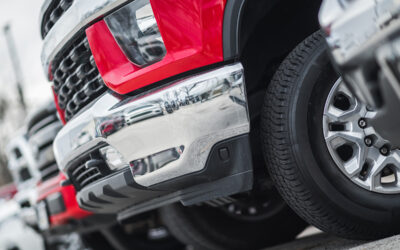Vehicle Upfit
Commercial vehicles have to handle various tasks that personal vehicles don’t, which often means they need certain accessories and upgrades to improve their functionality and versatility. These modifications cater to specific needs, optimize performance, and enhance safety across diverse industries and business operations. From practical storage solutions to specialized equipment installations, vehicle upfits open up a world of possibilities for businesses seeking to tailor their fleet to meet unique requirements. Discover the endless potential and advantages (as well as a few things to watch out for) that vehicle upfits offer.
What Is a Vehicle Upfit?
Vehicle upfitting is a crucial aspect of optimizing commercial fleets that refers to the process of customizing or modifying vehicles to meet specific operational requirements, ensuring they are equipped to perform efficiently and safely in various industries. By tailoring vehicles to suit unique needs, organizations can enhance productivity, safety, and functionality while maximizing their return on investment. Whether it’s adding specialized equipment, storage solutions, or safety features, vehicle upfitting plays a pivotal role in empowering businesses to achieve their objectives with a well-equipped and reliable fleet.
Some common vehicle upfits that can enhance the versatility of commercial fleet vehicles include:
- Flatbeds. A flatbed upfit involves installing a flat, open cargo area on the back of a truck or chassis. This design allows for easy loading and transportation of large, bulky items that may not fit in a traditional enclosed cargo space. Flatbed upfits are commonly used in construction, landscaping, and delivery industries.
- Dump bodies. Dump bodies are upfits designed to enable vehicles to transport and unload loose materials, such as sand, gravel, or debris, by tilting the bed and discharging the contents. Dump bodies are extensively used in construction, mining, and waste management sectors.
- Bed drawers. Bed drawers are an interior upfit that can be added to trucks or vans to create organized storage space within the vehicle. These drawers provide convenient access to tools, equipment, or small parts, promoting efficiency and reducing clutter.
- Loading ramps. Loading ramps are practical upfits designed to facilitate the loading and unloading of heavy equipment, machinery, or cargo into the vehicle. They are particularly valuable for industries like moving services and equipment transportation.
- Snowplows. Snowplow upfits are installed on the front of trucks to clear snow and ice from roads, parking lots, and other surfaces during winter months. They are crucial for municipalities, landscaping companies, and businesses in areas with heavy snowfall.
Vehicle upfitting is a game-changer for commercial fleets across diverse industries like HVAC, electricians, plumbers, and construction. By customizing vehicles to suit the unique demands of each sector, upfitting ensures optimal performance and efficiency. HVAC companies can benefit from specialized storage solutions for tools and equipment, while electricians can have vehicles equipped with mobile workshops to carry out on-site repairs. Plumbers can optimize their fleet with upfits like bed drawers for easy access to pipes and fittings. Meanwhile, construction firms can rely on dump bodies and loading ramps to transport materials effortlessly. With tailored upfits, these industries can elevate their fleet capabilities, streamline operations, and enhance overall productivity.
Benefits of Vehicle Upfitting
Vehicle upfitting offers a range of benefits that can significantly impact businesses in various ways. Here are some of the top advantages to commercial vehicle upfits.
- Vehicle customization to accommodate company needs. Upfitting allows businesses to adapt their vehicles to meet specific operational requirements. Whether it’s adding specialized equipment or creating organized storage space, customized vehicles enable smoother workflows and enhance productivity.
- Heightened work efficiency. With upfitting, commercial vehicles are optimized to perform their intended tasks efficiently. The right upfits, such as mobile workshops or refrigeration units, enable employees to work more effectively on-site, reducing downtime and increasing overall job throughput.
- Improved safety features. Safety is paramount for any business, and upfitting can help in this area as well. Upgraded safety features, such as cargo partitions, improve driver and passenger safety by preventing shifting loads during transit, reducing the risk of accidents.
- Increased return on investment. Vehicle upfitting enhances the overall functionality and lifespan of commercial vehicles, leading to a higher return on investment. The ability to customize vehicles to better suit specific tasks ensures that businesses get the most value out of their fleet.
- Elevated brand recognition. Upfitting provides an excellent opportunity to brand commercial vehicles with logos, decals, wraps, and other visual elements. This transforms each vehicle into a moving billboard, increasing brand visibility and recognition wherever they go.
- Increased bottom line. Vehicle upfitting directly impacts the bottom line of businesses by fostering increased efficiency, safety, and brand recognition. The resulting benefits, including heightened productivity, decreased maintenance expenses, and improved customer perception, all culminate in higher revenue and profits.
Ways to Upfit a Vehicle
There are many different ways to upfit a vehicle to meet company needs and goals. Some of the most popular upfits include:
- Graphics and decals. Applying custom graphics and decals to the vehicle can enhance brand visibility and recognition. This turns the vehicle into a mobile advertising platform, promoting the company’s image wherever it goes.
- Cargo access. Upfitting can include the installation of features like side doors, rear doors, or sliding trays, making it easier to access the cargo area. This is particularly useful for delivery services or industries requiring frequent loading and unloading.
- Increased storage capacity. Adding roof racks, cargo carriers, or exterior storage compartments can increase the overall storage capacity of the vehicle. This is beneficial for industries where extra storage is vital.
- Storage organization. Interior upfits like shelving units, drawers, and toolboxes can help keep the cargo area organized and efficient. This is crucial for service industries where specific tools and equipment need to be readily accessible.
- Flooring. Upgrading the flooring with materials like rubber mats or non-slip surfaces can improve safety and protect the vehicle’s interior from wear and tear. This is valuable for industries dealing with heavy equipment or potentially messy materials.
- Partitions. Installing cargo partitions between the driver’s compartment and the cargo area enhances safety by preventing shifting loads and securing the driver in case of sudden stops or collisions.
- Industry-specific equipment. Tailoring upfits to meet industry-specific needs is one of the primary advantages of vehicle upfitting. For instance, HVAC companies can install ladder racks, electricians can have cable carriers, and food delivery businesses can add refrigeration units.
Incorporating these upfitting options can help businesses optimize their vehicles to align with their specific needs and objectives, ultimately improving operational efficiency and achieving their goals more effectively.
What to Consider Before Upfitting
Before investing in vehicle upfitting, it’s crucial to make informed decisions and avoid common pitfalls. The process of customizing vehicles to suit specific needs can significantly enhance functionality and productivity for businesses. However, to ensure a successful upfitting experience, consider the following dos and don’ts to maximize the benefits while avoiding potential challenges and unnecessary expenses.
Dos
- Explore available upfits before you purchase a vehicle.
- Know your budget before you kick off the process.
- Make a plan for how you are going to manage the upfitting process.
- Understand the specifications of your vehicle.
Don’ts
- Make the decision on your own, especially if you are managing a fleet. Involve relevant parties and employees in the decision-making process.
- Be afraid of the investment. Sometimes upfits can be costly, but they can make up for it in the long run when properly planned.
- Try to make the upfit suit individual employees. While considering employee input is important, customizing upfits for each individual can be impractical and costly.
Solutions from Summit Fleet
Summit Fleet offers a hassle-free solution to vehicle upfitting by providing flexible fleet rentals. With our services, businesses can bypass the complexities of purchasing and customizing vehicles for their specific needs. By opting for fleet rentals, companies can save significantly on the acquisition, depreciation, and upfitting costs. The burden of investing in specialized upfits is eliminated, allowing businesses to focus on their bottom line and core operations.
At Summit Fleet, we ensure that clients have access to a diverse range of fully equipped vehicles tailored to their industry requirements, streamlining their operations and maximizing productivity. This seamless approach to fleet management empowers businesses to make the most of their resources while ensuring they have the right vehicles at their disposal, all without the hassle and financial burden of traditional upfitting processes. Learn more about how Summit Fleet can help get the job done.






